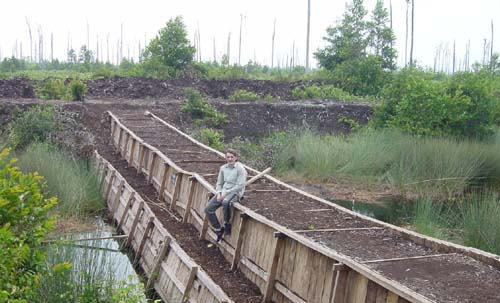CURRENT RESEARCH at the Department of Forest Sciences
RESPEAT 2021-2025
TURNEE 2021–2023
TROPDEC 2017-2022
MaaTi 2021-2022
Tropical peatlands
(Jyrki Jauhiainen, Harri Vasander)
In their pristine state, humid tropical peatlands in SE Asia are peat swamp forests with a generally thick peat layer. Nowadays the fastest change of land-use globally is occurring in these ecosystems. This causes severe effects on C stocks and sequestration, biodiversity, ecosystem services, and socioeconomy of local people. In collaboration with several international organizations, we have conducted studies in the C cycle, land-use change, restoration, and the environmental effects of acid sulphate soils in Indonesia, Malaysia and Vietnam.
Description

A dam constructed for experimental restoration of hydrology in the former Mega-Rice project area, Kalimantan. The lifetime of the dam was two years.
(Last updated 27/8/2021)
RECENT RESEARCH
Peatland forestry and climate (Kari Minkkinen, Paavo Ojanen)
For over two decades, carbon cycling and greenhouse gas emissions of peatlands drained for forestry have been studied in the Peatlanders group. Currently we are focusing on two themes: Root production and turnover (see PeatRoot) and climatically sustainable forestry and land-use (see below).
Based on our previous research we know that especially nutrient-rich drained peatland soils are considerable sources of greenhouse gases. In the same time, they have the highest potential among peatlands for wood production. Together with colleagues from the Finnish Meteorological Institute and the Natural Resources Institute Finland, we explore the possibilities of continuous cover forestry for combining profitable wood production with the reduction of greenhouse gas emissions from soil. Currently we are carrying out a partial harvest experiment at Lettosuo in Southern Finland. Funding: Nessling Foundation (2015–2017).
Project web page
In addition to the empirical work, we follow two modelling study lines: 1) Together with colleagues at the University of Gothenburg, Sweden, we are calibrating the mechanistic ecosystem carbon cycle model Coup for forestry-drained peatlands to understand processes controlling their carbon balance and to simulate full-rotation carbon balance (2016–2018). Funding: The Swedish Research Council Formas.
2) We are modelling climate forcing scenarios of forestry-drained peatlands under several land-use options (rotation forestry, continuous cover forestry, abandonment, rewetting). With this, we explore the potential of land-use decisions on forestry-drained peatlands to mitigate climate change (2017–2020). Funding: Kone Foundation.
Sustainable use of drained peatlands 2019–2020 (Paavo Ojanen, Kari Minkkinen)
In Finnish: Ojitettujen soiden kestävä käyttö
Finland is a leading country in draining peatlands for forestry and agriculture. While providing well-being for the country, drainage has also resulted in considerable greenhouse gas emissions, nutrient and suspended solid loading to watercourses and loss of mire habitats.
Together with colleagues from other Finnish universities and research institutes, we put together the up-to-date scientific knowledge on the effects of peatland drainage on environment and nature in popularized form in Finnish. We aim at providing the practitioners of agriculture and forestry an answer to the question: How peatlands can be utilized ecologically as sustainably as possible for agriculture and forestry? Different silvicultural and agricultural methods, land-use change between agriculture and forestry and rewetting for paludiculture or nature conservation are covered.
Funding 2019–2020: Finnish Forest Foundation
PeatRoot: Root-related carbon fluxes – missing pieces in the boreal peatland carbon balance puzzle 2015–2019 (Kari Minkkinen, Petra Straková)
In Finland, about 80% of soil C is found in peatlands. Forestry use and changing climate are threatening to release some of this C back to the atmosphere. C fluxes related to fine roots – production, turnover, decomposition and production of extramatrical mycorrhizal mycelia – remain unknown components in the C balance of peatland ecosystems. In this project we will quantify these C fluxes in both pristine and drained peatlands representing different hydrological and nutrient regimes, and estimate their responses to changing climatic conditions.
This is a joint project with the Natural Resources Institute Finland and the ForSoil research group. Funding: Academy of Finland.
LIFEPeatLandUse: Quantification and valuation of ecosystem services to optimize sustainable re-use for low-productive drained peatlands 2013–2018 (Kari Minkkinen, Paavo Ojanen)
More than half of the mire area in Finland has been drained to increase tree growth. However, tree growth has remained low in part of these drained wooded peatlands mainly due to nutrient poor peat soils. These low-productive drained peatlands, where timber production is currently not commercially productive , cover 20% (ca. 0.8. million ha) of the drained peatland area in Finland, mostly situated in Northern Finland. What to do with these low-productive drained peatlands that have been left aside from active forestry?
These low-productive peatlands can be re-used in many ways. For example, some of these areas may be suitable for peat harvesting, which is planned to be continued at least for the next decades to safeguard domestic energy production. Areas with high ecological or wildlife values could be restored. The aim of this project is to assess the impacts of different reuse options on biodiversity, environment and economy to find sustainable re-use options for these peatlands.
This is a joint project of several universities, research institutes and other collaborators in Finland. Funding: EU LIFE+ (LIFE12ENV/FI/150).
Project web page
SNS-120: Anthropogenic Greenhouse Gas emissions from organic forest soils: improved inventories and implications for sustainable management 2016–2019 (Jyrki Jauhiainen, Kari Minkkinen, Paavo Ojanen)
Together with colleagues from the Natural Resources Institute Finland and Nordic and Baltic countries, we synthesize knowledge on greenhouse gas emissions from peatland forests to create reliable emission factors, to propose climate change mitigation measures and to identify knowledge caps and create an agenda for future research. Funding: SNS Nordic Forest Research.
Project web page